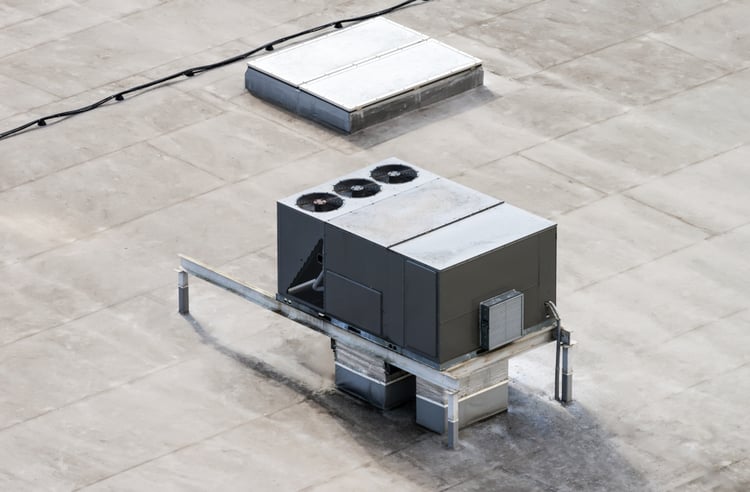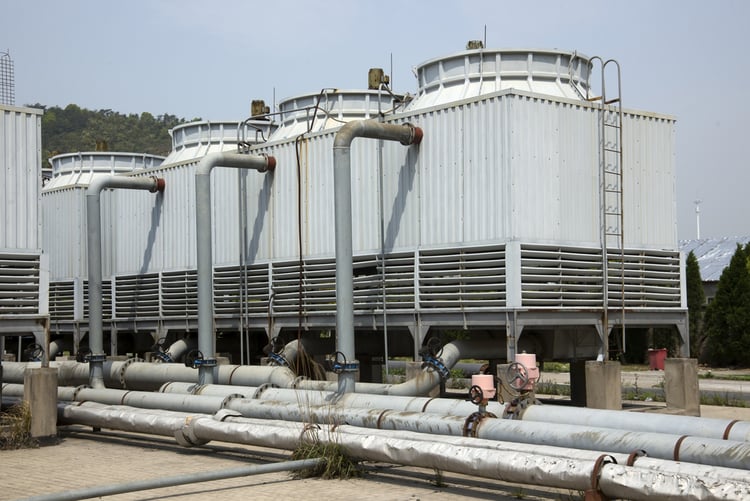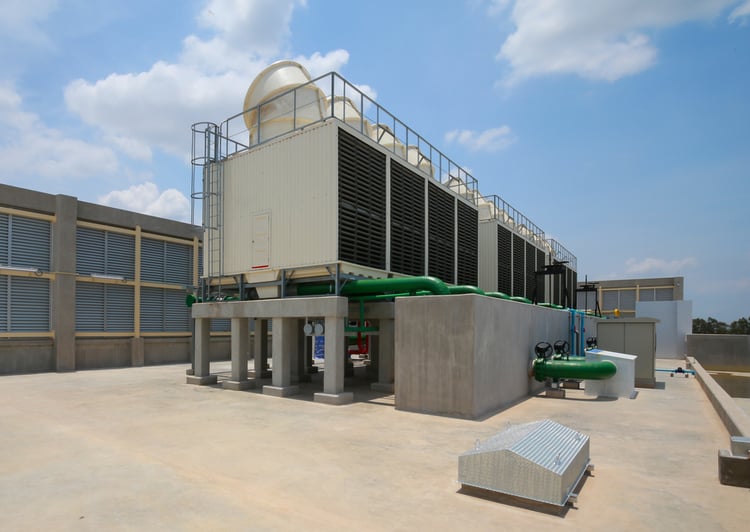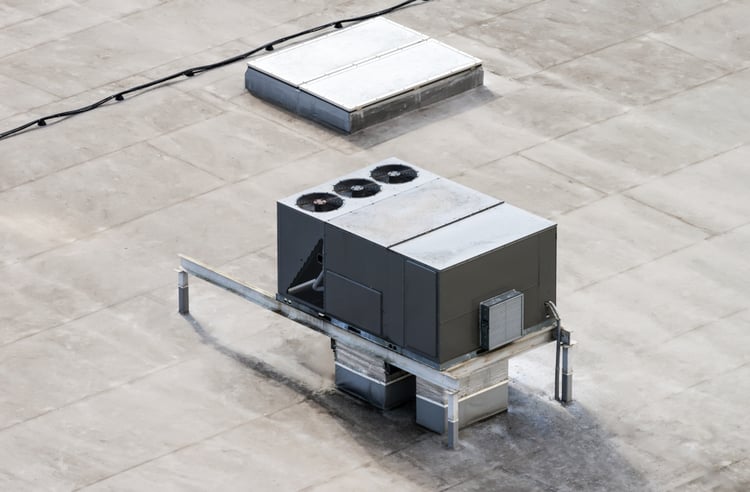In commercial buildings, HVAC loads typically represent the largest energy expenditure. Geographic location plays a significant role: buildings located in the north or south of the world typically have high heating expenses, while those located in the tropics may require year-round air conditioning.
Just like in residential environments, there is a wide range of heating and cooling options for commercial buildings, each with advantages and limitations. Three of the most commonly used systems for commercial buildings are:
- Variable air volume (VAV) systems with an integrated rooftop unit
- Cooling systems, cooling tower and boiler
- Water source heat pump systems with cooling tower and boiler
Are you planning a commercial real estate project? Get a professional HVAC project.
1) VAV system with packaged roof unit
 Rooftop packaged units (RTUs) typically include a condenser for air conditioning and a gas or electric boiler for space heating. In climates where the unit must provide conditioned air with low outdoor humidity, it is also possible to add an economizer, which reduces the cooling load on the condenser. In all operating modes, fans are used to blow air into a duct system that distributes it between separate interior zones.
Rooftop packaged units (RTUs) typically include a condenser for air conditioning and a gas or electric boiler for space heating. In climates where the unit must provide conditioned air with low outdoor humidity, it is also possible to add an economizer, which reduces the cooling load on the condenser. In all operating modes, fans are used to blow air into a duct system that distributes it between separate interior zones.
- Each zone has a variable air volume (VAV) box with a damper that opens and closes according to cooling or heating needs.
- The position of the damper is controlled based on the temperature set point of each specific zone. For example, the damper will open fully if a specific zone requires maximum cooling or heating power.
Traditional VAV systems suffer a drastic reduction in energy efficiency when subjected to partial load conditions: if all areas of the building are at partial load with their dampers semi-closed, duct pressure increases and the system can become noisy . Furthermore, the extra pressure represents a waste of fan energy. However, it is possible to obtain excellent results through the use of automation and frequency inverters:
- A control system constantly evaluates the status of all VAV boxes. Ideally, at least one of them should be fully open; otherwise, fan energy will be wasted.
- If none of the dampers are fully open, the fan speed is reduced and all dampers are gradually opened until one damper reaches the fully open position.
- At this point, the fan provides the correct airflow for the current HVAC load.
There can be considerable savings in fan power when the speed is controlled via a variable frequency drive. In general, fan power is proportional to speed cubed – a fan running at 90% speed consumes only about 73% of the power it would at full speed. An additional benefit of speed control is that noise is drastically reduced.
VAV systems with packaged rooftop units are practical in installations that have a large roof area proportional to their interior space, as air is the main medium used to transport heat. These systems are not practical in multi-story buildings due to the limited roof area and long vertical distances involved; Systems based on water-cooled chillers or water source heat pumps are preferred in these applications.
2)Chiller with cooling tower and boiler
 These systems use water as a medium to supply or extract heat, and the water circuits pass through air handling units (AHUs) that provide the necessary airflow to each zone of the building.
These systems use water as a medium to supply or extract heat, and the water circuits pass through air handling units (AHUs) that provide the necessary airflow to each zone of the building.
- In cooling mode, the chiller extracts heat from the cold water circuit that circulates throughout the building and rejects it into a secondary water circuit that is connected to the cooling tower. The cooling tower then rejects the heat to the outside.
- In heating mode, the circulating water passes through a boiler. Most boilers are powered by electricity, gas or oil.
In both cases, heat is exchanged between the circulating water and the indoor air in the AHUs. If the chiller and boiler share a water circuit (two-pipe system), the entire building must operate in heating or cooling mode; however, when there is a separate water circuit for each operating mode (four-pipe system), simultaneous heating and cooling can be provided to different zones. Of course, a four-pipe system is more expensive because the piping and fittings are essentially duplicated.
Just as in the case of VAV systems, considerable savings can be achieved with control and automation:
- Modern chillers typically come with variable speed compressors, which can operate efficiently even under partial load conditions. Some models combine speed control with step operation to further increase efficiency.
- Variable speed drives can be used for multiple system components, including cooling tower fans, water pumps, and air handling units.
- There are also economizers for water-cooled systems, but they only apply to specific climate zones, where the system will provide conditioned air with low outdoor humidity.
Chiller-based systems typically offer higher efficiency than VAV systems and are also more practical for multi-story buildings: instead of having several rooftop units grouped together, it is possible to consolidate the system into a single chiller and cooling tower, and only the cooling tower should be located outdoors or on the roof.
3) Water source heat pump system with cooling tower and boiler
 Commercial HVAC systems based on water source heat pumps tend to be the superior choice in terms of versatility and energy efficiency. Heat pumps are based on the refrigeration cycle, like air conditioners, but offer reversible operation; When multiple heat pumps are used to serve separate areas of a commercial building, they can switch between cooling and heating modes as needed.
Commercial HVAC systems based on water source heat pumps tend to be the superior choice in terms of versatility and energy efficiency. Heat pumps are based on the refrigeration cycle, like air conditioners, but offer reversible operation; When multiple heat pumps are used to serve separate areas of a commercial building, they can switch between cooling and heating modes as needed.
- All heat pumps in a building share a common water circuit and will reject or absorb heat depending on the needs of each zone.
- Because the water circuit is shared, equal heating and cooling loads balance each other.
- If the cooling load is greater, a cooling tower is used to reject the extra heat; on the other hand, if the heating load is higher, a boiler is used to compensate for the difference.
As in the two previous scenarios, it is possible to make the system even more efficient by adding speed control to all pumps and fans used. Heat pumps are among the most efficient heating and cooling systems on the market: they can match or exceed the efficiency of a chiller in cooling mode and, in most cases, can provide space heating with less than 40% of the energy consumption. of resistance. heater.
The need to install a dedicated heat pump for each area of the building increases the cost of these systems, but this is compensated in the long term thanks to the superior energy efficiency achieved. For example, if there is a time when the cooling and heating loads are equal, this system can operate with the boiler and cooling tower turned off.
Conclusions
One of the most important design choices in a commercial building is the HVAC configuration, as this system represents a significant portion of the long-term ownership costs. Building layout is an important consideration: low-rise facilities with large footprints tend to favor compact penthouse units with VAV systems, while multi-story buildings tend to favor the use of chillers or water source heat pumps.
Of course, there are viable energy efficiency improvements that can be implemented in all cases. Modulating the speed of compressors, pumps and fans is more energy efficient than turning these equipment on and off, and also contributes to longer life and reduced maintenance expenses.

